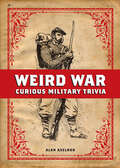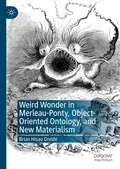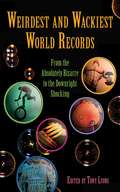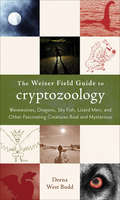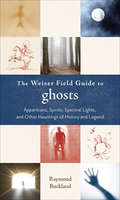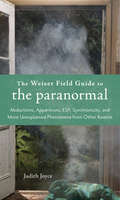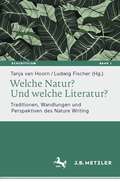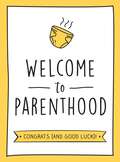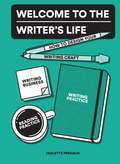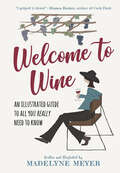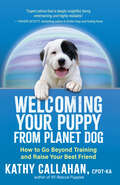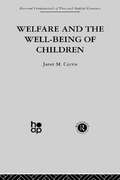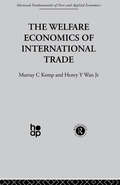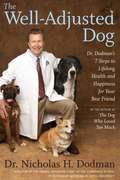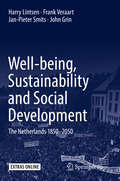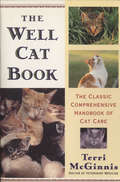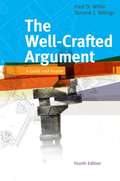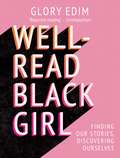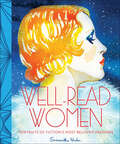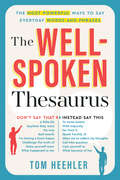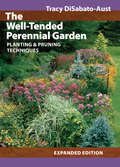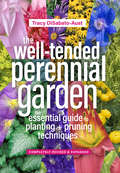- Table View
- List View
Weird War: Curious Military Trivia
by Alan AxelrodStrange facts and bizarre anecdotes from centuries of armed conflict fought with everything from machetes to machine guns.In this thought-provoking and highly entertaining book, Alan Axelrod, author of The Real History of World War II and many other titles, takes a journey through some of the lesser-known aspects of military history. Discover over a hundred fascinating, startling, or just plain odd facts and stories:Commanders—the good, the bad, and the lucky Defeats snatched from the jaws of victoryThe real reason American paratroopers bellowed “Geronimo!” when jumping out of their transport planesWhat—aside from German bombs—caused some of the more unlucky casualties of the London Blitz The shortest war in history—which lasted exactly 38 minutesand much more
Weird Wonder in Merleau-Ponty, Object-Oriented Ontology, and New Materialism
by Brian Hisao OnishiThis book connects recent developments in speculative realism, new materialism, and eco-phenomenology to articulate an approach to wonder that escapes the connected traps of anthropocentrism and correlationism. Brian Onishi argues that wonder has explanatory power for the constitution of the world and the organization of meaning. To do this, he appeals to both fiction (speculative and Weird fiction in particular) and quantum physics. More specifically, he argues that the focus of Weird fiction on impossible experiences and a feeling of something just beyond the limits of one’s grasp dramatizes the speculative reach beyond the limits of our understanding. But more than a tool for knowledge acquisition, wonder is an organizing property of objects. Like the collapse of superposition in quantum physics, reality is constituted when objects reveal themselves to other objects and thereby organize themselves into complex objects. Since no relation is exhaustive, the capacity to wonder remains at a material level, and the possibility of reorganization is ever present. Ultimately, Onishi argues for a speculative eco-phenomenology with wonder as an engine for a Weird environmental ethics.
Weirdest and Wackiest World Records: From the Absolutely Bizarre to the Downright Shocking (Zen of Zombie Series)
by Tony LyonsWho knew that one could make a claim to fame in such an unorthodox way? The Weirdest and Wackiest World Records may not list the most traditional achievements, but it sure will leave readers speechless. From astonishing eating records to man's most absurd "talents," this book delves into the unconventional actions taken by many to make their milestone. Some of these "achievements" are: - Hairiest Man-Victor "Larry" Ramos Gomez, with 98% of his body covered- Most Tattoos on a Senior Citizen-Isobel Varley, with 93% of her body covered- Longest Distance on a Unicycle for Twenty-Four Hours- Sam Wakeling, who covered 281.85 miles in 2007 - Most Asparagus Eaten in Ten Minutes-Joey Chestnut, with 9 lbs., 5.2 oz. in 2011 - And hundreds more! Sure to leave you shocked, amused, and entertained, The Weirdest and Wackiest World Records is the perfect source to learn about the most bizarre feats that have ever been successfully attempted. So whether you're fascinated by the crazy people who set these records or are looking for an insane record to break, you'll most certainly find it here. This is a book you will have to read to believe!
The Weiser Field Guide to Cryptozoology: Werewolves, Dragons, Skyfish, Lizard Men, and Other Fascinating Creatures Real and Mysterious (The Weiser Field Guide)
by Deena West BuddA study of dozens of hidden animals—from the chupacabra to Mongolian death worms—drawing on eyewitness accounts from around the world. This informative book includes information, interviews, and stories about forty different cryptids seen around the world by credible eyewitnesses like policemen, rangers, and doctors. Readers will learn where and how to find flying humanoids, hairy humanoids, giants of all kinds including rabbits, bats, and spiders, goblins, vampires, werewolves, demons, aliens, and ghosts. Cryptozoology—a term coined in the 1950s by a French zoologist named Bernard Heuvelmans—is the study of hidden or unknown animals not recognized in standard zoology. From traditional cryptids like Big Foot, the Abominable Snowman, and Nessie, to mythical cryptids like unicorns, vampires, dragons, and werewolves, to lesser-known cryptids like bunyips (waterhorses), Encantado (Dolphin Men of Brazil), thunderbirds, mothmen, and chupacabra, these creatures are very much alive, says expert Deena West Budd, if beyond the realm of normal perception. The Weiser Field Guide to Cryptozoology includes a brief history of the field and surveys all the creatures for which any credible amount of research exists—as well as giving tips on how to spot these creatures and cautionary advice on how to interact with them. Includes two dozen line drawings rendered from eyewitness descriptions
The Weiser Field Guide to Ghosts: Apparitions, Spirits, Spectral Lights and Other Hauntings of History and Legend (The Weiser Field Guide)
by Raymond BucklandA reference guide to the otherworld—includes illustrations. From battlefield and biblical ghosts to poltergeists and orbs, The Weiser Field Guide to Ghosts examines categories and subcategories of ghosts across time and cultures, including commonalities and misconceptions. Stories of encounters, legendary ghosts, and haunted places are all covered in this beautifully illustrated compendium, a veritable A-Z of the otherworld. The Weiser Field Guide to Ghosts is concise and comprehensive—and also includes practical tips on ghost hunting and suggested further reading.
The Weiser Field Guide to the Paranormal: Abductions, Apparitions, ESP, Synchronicity, and More Unexplained Phenomena from Other Realms (The Weiser Field Guide)
by Judith JoyceAn A-to-Z resource on paranormal phenomena, with illustrations. Stranded motorists on a lonesome road are rescued by angels. The phone rings with a call from beyond the grave. A blood-sucking predator is sighted in the south of Texas. The Weiser Field Guide to the Paranormal is your gateway into the world beyond the known. Covering topics from cryptids to psychics, telekinesis to telepathy, this concise, alphabetized handbook will guide you through the eerie, the undeniable, and the strange world of the paranormal. Once upon a time, events like ghost sightings were commonplace. Parlors were redecorated to accommodate seance rituals, and ghost stories poured from the culture. Psychic occurrences and abilities might have been feared and disliked, but they were accepted as a normal part of life. Today, we are experiencing a resurgence of all things paranormal. Join paranormal investigator and psychic Judith Joyce as she delves into this world with haunting detail and illuminating clarity. Joyce touches on all of the major aspects of paranormal phenomena, and more. Do you have telepathic powers? Can the Ouija board really speak from the Other Side? Use this paranormal primer to find out.
Welche Natur? Und welche Literatur?: Traditionen, Wandlungen und Perspektiven des Nature Writing (Ecocriticism. Literatur-, kultur- und medienwissenschaftliche Perspektiven #1)
by Tanja Van Hoorn Ludwig FischerMit diesem Band gewinnt die deutschsprachige Forschung transdisziplinär Anschluss an die internationalen Nature Writing-Diskussionen. Der Sammelband sondiert das Feld des Nature Writing hinsichtlich der Frage, welche Natur dabei in den unterschiedlichen historisch-kulturellen Konstellationen in jeweils welcher spezifischen literarischen Textur zur Darstellung kommt. Programmatisch-konzeptionell stehen damit nicht zuletzt die (möglicherweise verdeckt normativen) Naturvorstellungen des klassischen und rezenten Nature Writing zur Diskussion. Dies wird in exemplarischen Lektüren untersucht, etwa, indem die Kategorien einer ›unberührten‹ Natur bzw. des ›Wilden‹ – auch im Kontext des sogenannten Rewilding – problematisiert oder aber die ästhetisch geformte Darstellung zivilisatorisch veränderter, sei es anthropogen zerstörter, sei es gärtnerischer gestalteter Natur analysiert wird. Präsentiert werden Beiträge aus amerikanistischer, germanistischer, philosophischer und biologiegeschichtlicher Perspektive zu prominenten Vertreter*innen des englischsprachigen Nature Writing (Henry David Thoreau, Val Plumwood u.a.) ebenso wie zu indigenem Natur-Wissen (Robin Wall Kimmerer) und zu Werken deutschsprachiger naturaffiner Autor*innen der Tradition (Adalbert von Chamisso) und Gegenwart (z.B. Ulrike Draesner, Esther Kinsky und W.G. Sebald). Die Untersuchungen ästhetischer Natur-Darstellungsverfahren erfolgen in close readings sowie im Horizont von politischer Ökologie, New Materialism, Ecocriticism, den seit geraumer Zeit gerade in England geführten Diskussionen zu Möglichkeiten und Grenzen eines New Nature Writing und den jüngsten Bestrebungen, die verschüttete Linie eines deutschsprachigen Nature Writing zu rekonstruieren.
Welcome to Parenthood: A Hilarious New Baby Gift for First-Time Parents
by Summersdale PublishersYou’ve created a human alarm clock without a snooze button!Welcome to the life-upending, sleep-thieving, crazy old business known as parenthood. The hours are long and the pay is non-existent, but the rewards are priceless. They better be.You’re in for quite a ride, but this hilarious gift book is here to tell it like it is, respect the struggle and help you see the funny side. A blend of real talk, hard-won wisdom and relatable observations, this is the perfect antidote to all those well-meaning myths about the unbelievable journey that you and your little one have just begun.The realizations that are going to dawn on you pretty fast include:Just think, in a couple of years that little angel will be calling you a poo-head.Despite all the boundaries you set, sometimes you are going to have to let the baby win.Your biggest daily achievement is now getting another human to burp.This is the perfect gift for anyone with a new baby and a sense of humour.
Welcome to the Writer's Life: How to Design Your Writing Craft, Writing Business, Writing Practice, and Reading Practice
by Paulette PerhachAlways wanted to be a writer? Stop wasting time and start your writing life today! With warmth and humor, the author welcomes you into the writer’s life as someone who has been there on the other side looking in. Like a freshman orientation for writers, this book includes an in-depth exploration of all the elements of a writer's life, from your writing practice to your reading practice, to your writing craft and the all-important and often-overlooked business of writing. Harness the powers of crowdsourcing and social media to grow your writing career, and use the most current research on success, gamification, and lifestyle design to take your writing life to the next level. Complete with writing exercises, tools, checklists, infographics, and behind-the-scenes tips from working writers of all types, this book offers everything you need to jump-start a successful writing life.
Welcome to Wine: An Illustrated Guide To All You Really Need To Know
by Madelyne MeyerFrom food pairings to the art of wine tasting, this charmingly illustrated guide makes the world of wine more welcoming than ever! Calling all wine newbies and wine nerds: This illustrated guide is refreshing as a rosé and flavorful as a merlot. Growing up in a family that’s been in the wine business for five generations, Madelyne Meyer would be the first to tell you, you don’t need a book to enjoy wine . . . but knowing more about your favorite glassful can be a pleasure all its own. In Welcome to Wine, Meyer pairs her expert knowledge with 200 witty, whimsical illustrations that make all the essentials crystal clear—so you can get to the good part sooner! Food pairings and the art of wine tasting Serving temperature (without getting hung up on precision!) Key wine regions and exactly how wine is made From choosing wine fora date night to training your nose to pickup “notes,” this is the friendliest guide to wine.
Welcoming Your Puppy from Planet Dog: How to Go Beyond Training and Raise Your Best Friend
by Kathy CallahanWritten in a fresh, warm voice loaded with empathy, Welcoming Your Puppy from Planet Dog lights the path to a relaxed, happy interspecies household “I truly LOVE this book. If I were fostering, breeding, or getting a new puppy, I’d read it twice, and still keep it within reach every day.” — Dr. Patricia McConnell, applied animal behaviorist, speaker, and author of The Other End of the Leash and The Puppy Primer After a decade of guiding people who’ve just added a puppy to the family, dog trainer Kathy Callahan has learned a fundamental truth: at some point every one of them feels overwhelmed. When they seek out expertise, they’re flooded with impossibly detailed advice, conflicting opinions, and a surprising number of techniques that seem unkind. In contrast, Callahan reassures owners that success flows not from nailing an intimidating list of disciplinary tactics, but from adopting a mindset of “trusted guide” rather than “master.” The key to great training is recognizing that we have essentially kidnapped these puppies from their own vastly different culture. Using an easy-to-grasp “Planet Dog / Planet Human” concept, Callahan dives into the puppy essentials, including: • how to prepare your house (and yourself) for puppyhood • potty training, chewing, jumping, and other challenges • how to train with fun, not fear • why it might seem your puppy “just doesn’t listen” • navigating puppyhood with young kids, cats, and/or other dogs • what to do if there’s household disagreement on things like whether dogs belong on furniture In fun-to-read chapters filled with empathy for both the beleaguered humans and their confused puppies, Welcoming Your Puppy from Planet Dog paves the way for a rewarding friendship between a relaxed, well-prepared human and a canine family member who’s happily at ease in our world.
Welding Handbook Volume 3
by American Welding SocietyThis authoritative resource brings together 600 pages of comprehensive information on solid-state and other welding and cutting processes. The book includes chapters on the following welding processes: resistance spot and seam, projection, flash and upset, and high-frequency. The final chapter covers various other welding and cutting processes, including modernized water jet cutting. Written, updated, and peer reviewed by a group of highly respected technical and scientific experts.•Provides a comprehensive chapter on resistance welding equipment, with photos of state-of-the-art equipment and accompanied by new electrical diagrams and drawings.• In addition to a chapter on friction welding, a new chapter introduces friction stir welding, the process that has users excited about its significant advantages.• Discusses the most recent developments in beam technology in greatly expanded chapters on laser beam welding and cutting and electron beam welding.• Presents a diverse array of processes in chapters on ultrasonic welding, explosion welding, diffusion welding and diffusion brazing, adhesive bonding, and thermal and cold spraying.• Also discusses various other welding and cutting processes, including sections on two emerging processes: magnetic pulse welding and electro-spark deposition, plus the return of water jet cutting as a modern process.• Includes a section on safe practices specific to the process in each chapter. This volume is devoted to information on resistance welding, solid state processes, and other joining and cutting methods. It contains updated resistance welding chapters: spot and seam welding, projection welding, flash and upset welding, high-frequency welding, and resistance welding equipment. The chapter on friction welding been updated. New in this edition is a separate chapter on the developing process variation of friction stir welding. Other chapters explore ultrasonic welding, explosion welding, adhesive bonding, thermal spraying and cold spraying, diffusion welding, and diffusion brazing. The chapters on electron beam welding and laser beam welding and cutting contain significantly expanded technology. The last chapter, Other Welding and Cutting Processes, contains information on two new or revitalized processes, magnetic pulse welding, and electro-spark depositing. New information is presented on water jet cutting, which is reappearing in many current applications as a modern, efficient process.
Welfare and the Well-Being of Children (Fundamentals Of Pure And Applied Economics Ser. #Vol. 59.)
by J. CurrieThis book examines the major US welfare programs affecting children and presents a systematic evaluation of the evidence regarding the effects of welfare programs on the children themselves.
The Welfare Economics of International Trade (Fundamentals Of Pure And Applied Economics Ser.)
by M. Kemp H. WanThis book provides a careful account of the leading propositions about the welfare gains associated with international trade and investment under differing institutional arrangements and policy choices.
The Well-Adjusted Dog: Dr. Dodman's 7 Steps to Lifelong Health and Happiness for Your Best Friend
by Dr. Nicholas H. DodmanOne of the greatest myths in dog ownership is that once a puppy is housetrained and has graduated from a puppy training class, an owner’s work is done. In fact, that work is just beginning.Drawing on some twenty-five years of clinical experience, Dr.Dodman offers what he calls "continuing education" for dogs and their owners. You will discover • how much exercise your dog really needs (and why) • how diet can affect behavior • how to communicate clearly with your dog and understand dog body language • how to lead your dog, not dominate him • how to optimize your dog’s environment • how to address medical problems that might underlie unwanted behavior Dr.Dodman’s comprehensive, seven-step approach takes on the whole dog—his health, behavior, and environment—and lays the groundwork for the proper care and training of your best friend, for life.
Well-being, Sustainability and Social Development: The Netherlands 1850–2050
by John Grin Jan-Pieter Smits Frank Veraart Harry LintsenThis open access book examines more than two centuries of societal development using novel historical and statistical approaches. It applies the well-being monitor developed by Statistics Netherlands that has been endorsed by a significant part of the international, statistical community. It features The Netherlands as a case study, which is an especially interesting example; although it was one of the world’s richest countries around 1850, extreme poverty and inequality were significant problems of well-being at the time. Monitors of 1850, 1910, 1970 and 2015 depict the changes in three dimensions of well-being: the quality of life 'here and now', 'later' and 'elsewhere'. The analysis of two centuries shows the solutions to the extreme poverty problem and the appearance of new sustainability problems, especially in domestic and foreign ecological systems. The study also reveals the importance of natural capital: soil, air, water and subsoil resources, showing their relation with the social structure of the ‘here and now´. Treatment and trade of natural resources also impacted on the quality of life ‘later’ and ‘elsewhere.’ Further, the book illustrates the role of natural capital by dividing the capital into three types of raw materials and concomitant material flows: bio-raw materials, mineral and fossil subsoil resources. Additionally, the analysis of the institutional context identifies the key roles of social groups in well-being development. The book ends with an assessment of the solutions and barriers offered by the historical anchoring of the well-being and sustainability issues. This unique analysis of well-being and sustainability and its institutional analysis appeals to historians, statisticians and policy makers.
The Well Cat Book: The Classic Comprehensive Handbook of Cat Care
by Terri McginnisFeaturing sections on daily care, preventive medicine, and training, The Well Cat Book teaches cat owners how to detect signs of illness, diagnose problems, and begin home treatment--thereby avoiding expensive and often unnecessary trips to the vet. Includes over 100 illustrations and step-by-step instructions.From the Trade Paperback edition.
The Well-Crafted Argument: A Guide and Reader
by Fred D. White Simone J. BillingsThe Well-Crafted Argument equips students with a comprehensive set of skills necessary for writing argumentative essays in a wide variety of contemporary social contexts. Based on a process pedagogy that encourages individual voice and vision, the book introduces models of good writing for inexperienced writers. Divided into two parts, a rhetoric and a reader, it provides instructors and students with a wealth of materials and tools for effective argumentative writing, thinking, and reading.
The Well-Crafted Argument: A Guide and Reader (4th Edition)
by Fred D. White Simone J. BillingsIncorporating new articles, expanded commentary, and the latest changes from the 2009 MLA Handbook and 2009 APA Publication Manual, the 4th Edition of THE WELL-CRAFTED ARGUMENT guides students through the process of writing effective arguments across the disciplines. The two-part structure of this rhetoric/reader includes a complete pedagogical apparatus--with coverage of critical reading strategies, as well as writing, researching, and documenting a topic--and an anthology of readings grouped into nine thematic clusters. In-depth instruction, combined with real student writings, engages students and helps them discover their own voices. The Fourth Edition continues the visual emphasis from the 3rd Edition, while maintaining the authors' practical, skill-building approach. Each chapter in Part I ends with a "Summary," "Checklist," and "Writing Projects," while each cluster in Part II ends with "Connections Among the Clusters," "Writing Projects," and "Suggestions for Further Reading. " These sections encourage students to apply what they've learned and go beyond the classroom if a topic is of particular interest to them. In addition to guidance on drafting and revising arguments, the authors provide a variety of composition strategies, including freewriting, outlining, and shared reading.
Well-Read Black Girl: Finding Our Stories, Discovering Ourselves
by Glory Edim'Required reading.' - Cosmopolitan'This should be read as a sacred text. Here, you will bear witness to a perpetual salvation song.' - Jason ReynoldsRemember that moment when you first encountered a character who seemed to be written just for you? That feeling of belonging remains with readers the rest of their lives - but not everyone regularly sees themselves reflected on the pages of a book.In this timely anthology, Glory Edim, founder of the online community, Well-Read Black Girl, brings together original essays by some of America's best black women writers to shine a light on how important it is that we all - regardless of gender, race, religion, or ability - have the opportunity to find ourselves in literature. Whether it's learning about the complexities of femalehood from Zora Neale Hurston and Toni Morrison, finding a new type of love in The Color Purple, or using mythology to craft an alternative black future, each essay reminds us why we turn to books in times of both struggle and relaxation. As she has done with her book club-turned-online community, Edim has created a space where black women's writing, knowledge and life experiences are lifted up, to be shared with all readers who value the power of a story to help us understand the world, and ourselves.Contributors include: Jesmyn Ward, Lynn Nottage, Jacqueline Woodson, Gabourey Sidibe, Morgan Jerkins, Tayari Jones, Rebecca Walker, and Barbara Smith.'Essential reading for the twenty-first-century reader. This book is smart, powerful, and complete.' - Min Jin Lee, author of Pachinko
Well-Read Women: Portraits of Fiction's Most Beloved Heroines
by Samantha Hahn“They’re all here—Clarissa Dalloway, Dorothea Brooke, Nancy Drew—and each one is drawn so magnificently that their authors would rejoice as we rejoice.” —Emma Straub, New York Times bestselling author A treasure of a gift for the well-read woman, this collection brings together fifty stirring portraits, in watercolor and in word, of literature’s most well-read female characters. Anna Karenina, Clarissa Dalloway, Daisy Buchanan . . . each seems to live on the page through celebrated artist Samantha Hahn’s evocative portraits and hand-lettered quotations, with the pairing of art and text capturing all the spirit of the character as she was originally written. The book itself evokes vintage grace reimagined for contemporary taste. In the hand and in the reading, here is a new classic for the book lover’s library.“These women are important. They illuminate the world. So read, read, read their words. And learn what life is.” —Maira Kalman, bestselling author and illustrator of Beloved Dog“Richly illustrated and exquisitely hand-lettered, Well-Read Women is the perfect convergence of literature and art—and a wonderful gift for any passionate reader. I have devoured it already several times over.” —Lisa Congdon, artist and author of Find Your Artistic Voice“Samantha Hahn’s exuberant watercolors paired with sharply chosen quotes feel at once nostalgic and modern, stylish and genuine. All qualities befitting the complex women she renders.” —Stella Bugbee, Styles Editor, TheNew YorkTimes“The perfect collection of our favorite fictional heroines brought to life in gorgeous illustrations by the immensely talented Samantha Hahn—it’s destined to become a classic and inspire readers and artists alike.” —Christiane Lemieux, founder/CEO, The Inside, and author of Undecorate
The Well-Spoken Thesaurus: The Most Powerful Ways to Say Everyday Words and Phrases
by Tom HeehlerThe Well-Spoken Thesaurus is designed to help you improve your communication skills by expanding your vocabulary.The book includes over 200 words, arranged in easy-to-use categories, such as "positive emotions," "negative emotions," "intellectual terms," and "descriptive terms." Each entry includes a definition, synonyms, antonyms, and usage examples. The Well-Spoken Thesaurus is particularly useful for writers who want to improve the precision and impact of their language. By providing a range of synonyms for common words and phrases, the book helps writers avoid repetition and clichés, while also encouraging them to use language that is more vivid, specific, and memorable.Some of the benefits of using The Well-Spoken Thesaurus include:Making a stronger impression: By choosing words that are more precise and impactful, you can help your writing stand out from the crowd and make a stronger impression.Demonstrating your communication skills: Using a wide range of vocabulary can demonstrate that you are articulate, sophisticated, and able to communicate effectively.Conveying your personality: Includes a range of descriptive terms that can help you convey your personality and character traits in your writingOverall, The Well-Spoken Thesaurus can be a valuable resource for anyone who wants to improve their writing and communication skills.
The Well-Tempered Sentence: A Punctuation Handbook for the Innocent, the Eager and the Doomed
by Karen Elizabeth GordonEverything you ever wanted to know about punctuation marks using humorous examples.
The Well-Tended Perennial Garden: Planting & Pruning Techniques
by Tracy DiSabato-AustWith more than 180,000 copies sold since its original publication, The Well-Tended Perennial Garden has proven itself to be one of the most useful tools a gardener can have. Now, in this expanded edition, there's even more to learn from and enjoy. This is the first, and still the most thorough, book to detail essential practices of perennial care such as deadheading, pinching, cutting back, thinning, disbudding, and deadleafing, all of which are thoroughly explained and illustrated. More than 200 new color photographs have been added to this revised edition, showing perennials in various border situations and providing images for each of the entries in the A-to-Z encyclopedia of important perennial species. In addition, there is a new 32-page journal section, in which you can enter details, notes, and observations about the requirements and performance of perennials in your own garden. Thousands of readers have commented that The Well-Tended Perennial Garden is one of the most useful and frequently consulted books in their gardening libraries. This new, expanded edition promises to be an even more effective ally in your quest to create a beautiful, healthy, well-maintained perennial garden.
The Well-Tended Perennial Garden: The Essential Guide to Planting and Pruning Techniques, Third Edition
by Tracy DiSabato-Aust“This practical guide is lush with clear, step-by-step advice.” —Real Simple Since its original publication twenty years ago, The Well-Tended Perennial Garden has helped home gardeners successfully plan, plant, and tend their gardens. Now Tracy Di-Sabato-Aust’s trusty advice and reassuring tone are back and better than ever in this completely revised new edition. Novice and experienced gardeners alike will benefit from Tracy’s thorough details on the essential practices of perennial care—included deadheading, pinching, and thinning—along with growing information for new species and cultivars, on-trend garden design advice, a monthly planting and maintenance schedule, and details on native plants and gardening for wildlife. The Well-Tended Perennial Garden is a must-have ally in the quest for a beautiful, well-maintained garden.
